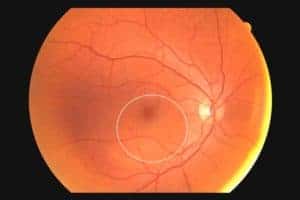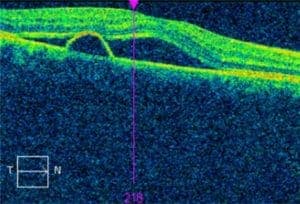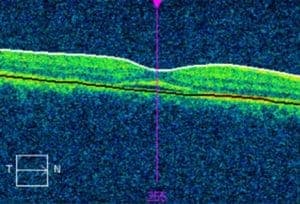Central Serous Chorioretinopathy Introduction
CSCR describes a condition where pockets of fluid collect under the retina (the photographic film in the camera in the back of the eye that lets you see). Accumulation of fluid in this space can disrupt vision and cause blurring in the affected eye. It typically affects young (20-50 year old) males up to 8-10 times more often than females.
CSCR is the 4th most common retinal condition following age-related macular degeneration, diabetic eye disease, and blockages of blood vessels (‘retinal vein occlusion’). CSCR has a very favourable prognosis in over 90% of patients, however recurrences can be common.
The exact cause remains unknown (what doctors call ‘idiopathic’) however certain risk factors influence its development.
Risk factors for CSCR
- Males are affected more commonly than females
- Race – Asians and Caucasians are at greater risk
- Corticosteroids – exposure to prescribed steroid medication (eg Prednisone, Hydrocortisone, Methylprednisone, Beclosmethasone) is strongly associated with CSCR. These medications are commonly prescribed for many conditions and are present in tablets, asthma puffers, nasal sprays, creams, gels and joint injections.
- Life stress or “Type A” personalities cause increased levels of cortisol in the body
- Pregnancy
- Poor or irregular sleep patterns, including shift work
What are the symptoms?
Patients will usually complain of blurred or distorted vision, and sometimes altered colour vision.
How is it Diagnosed?
Diagnosis is usually made by the specialist following a detailed history and examination. Investigations such as OCT (laser-guided scans of the back of the eye) and Fluorescein Angiography (a photographic test with dye)can also be used to confirm the diagnosis and monitor the progress.
Treatment
- Observation – over 90% of patients will resolve spontaneously (ie. get better by themselves) within 3-6 months. As such, patients are usually observed initially and if no improvement occurs, treatment options can be considered.
- Lasers – 2 types of laser treatment can be employed. These procedures are painless and performed in the office.
- Hot Laser – If the source of fluid leakage is a safe distance from your macula, heat can be applied to seal it.
- Cold Laser (aka. Photodynamic Therapy, or ‘PDT’) – PDT is employed when the source of the leak is close to the macula. A dye is injected into the bloodstream which accumulates in the leaking blood vessels and only becomes activated when exposed to a special laser light.
What Can You Do?
While the condition usually resolves with observation there are things we recommend to help prevent recurrence. These include:
- Discussing steroid alternatives with your doctors
- Stress reduction
- Regular healthy sleeping routine
Key Points
- CSCR is a common retinal condition usually affecting young males that has a very good prognosis.
- Treatment is usually observation and may involve modification of medicines and lifestyle.



Helpful links: YAG Laser Capsulotomy, Laser Retinopexy, SLT Laser
Contact us to get help with any questions you may have, or support you may need.

